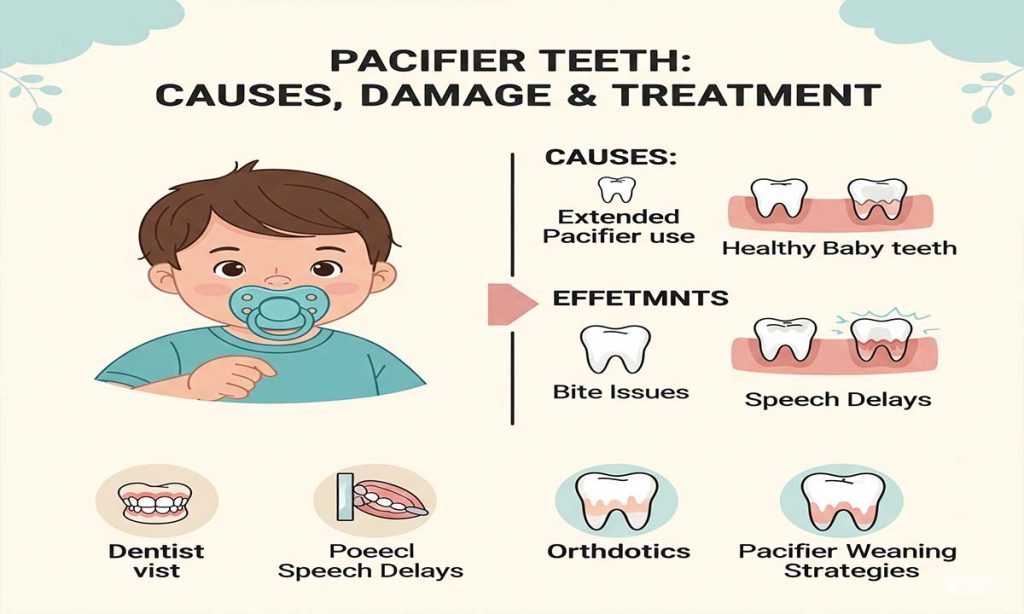Image: A toddler with a pacifier in her mouth. Pacifier teeth is a term used to describe dental changes that can occur when babies use pacifiers for extended periods. While pacifiers soothe infants, prolonged sucking can misalign developing teeth and jaws. In fact, roughly 75–85% of children use a pacifier at some point, making it a very common baby habit. Constant pressure from a pacifier on the gums and palate can push teeth out of position, leading to issues like an open bite (front teeth not touching) or a crossbite. Pediatric dentists warn that if pacifier use continues past the toddler years, these malocclusions become more pronounced and may require treatment. In this guide we’ll explain what pacifier teeth are, why they happen, their effects on oral health, and how to prevent or fix them.

Table of Contents
What Are Pacifier Teeth?
Pacifier teeth (sometimes called “binky bite”) isn’t a single tooth problem but a pattern of bite changes. It occurs because the sucking motion of a pacifier moves baby teeth and alters jaw growth. Common signs include open bite (a gap between upper and lower front teeth when biting) and crossbite (some upper teeth sit inside the lower teeth). Essentially, the pacifier acts like a placeholder that stops the teeth from coming together normally. Over time, the upper front teeth may protrude (overjet) or the palate may narrow. As one pediatric dentist explains, these issues happen when the pacifier puts constant pressure on the developing teeth and gums.
Causes of Pacifier Teeth
Several factors influence whether a child develops pacifier teeth. The key causes include:
- Extended Use (Age): The older the child and the longer they use a pacifier, the greater the risk of misalignment. Most pediatric dentists agree that using a pacifier beyond age 2–3 significantly raises the chance of dental issues. For example, one study showed that 71% of children who sucked a pacifier past 4 years had malocclusions, versus only 14% of those who stopped by age 2.
- Sucking Intensity: Babies who vigorously suck on a pacifier exert more pressure on their teeth than those who merely hold it passively. Intense, frequent sucking is more likely to push teeth out of place.
- Frequency of Use: Constant, around-the-clock pacifier use (not just at naps or bedtime) means teeth are under pressure much of the day, increasing the chances of distortion.
- Pacifier Design: Conventional round-nipple pacifiers tend to affect the bite more than modern orthodontic pacifiers. Orthodontic (physiologic) pacifiers have a flattened, asymmetric nipple designed to support the tongue and minimize forward pressure on the teeth. Research shows conventional pacifiers are more often linked to severe open bites and overjets, whereas orthodontic pacifiers cause fewer alterations.
- Thumb-Sucking or Other Habits: Often a pacifier is used in conjunction with thumb-sucking. Both are “non-nutritive sucking” habits and can compound effects on oral development.
Effects of Pacifier Teeth on Oral Health
If a pacifier habit isn’t stopped, the resulting malocclusion (misaligned bite) can have several impacts:
- Misaligned Bite: Prolonged pacifier use is strongly associated with bite problems. Typical effects include an open bite (front teeth gaps), crossbite, and increased overjet. One meta-analysis found a marked rise in malocclusion after 3–4 years of age. In practical terms, a child whose pacifier habit lasts into early childhood may need orthodontic correction later.
- Jaw and Palate Changes: Constant sucking can narrow the upper jaw and raise the palate. Over time, this can affect how the upper and lower jaws fit together. If unchecked, it may influence facial development and even breathing.
- Dental Development: Baby teeth guide the eruption of permanent teeth. If pacifier teeth distort the baby teeth, it can lead to crowding or spacing issues when adult teeth come in. For example, upper incisors can become flared outward.
- Speech and Eating: Severe bite misalignments can affect speech sounds (like “s” and “th”) and make biting or chewing less efficient. However, most pacifier-related bite changes in infants do not cause immediate speech delays.
- Need for Treatment: If pacifier teeth are significant, the child may eventually need orthodontic treatment. In fact, experts note that if the habit continues into school age, the child has a higher likelihood of needing braces or other intervention. Regular dental checkups can catch these issues early.
Preventing Pacifier Teeth (Safe Pacifier Use)
Good pacifier hygiene and timing can prevent most pacifier teeth problems. Key recommendations:
- Limit Duration: Begin limiting pacifier use by 12–18 months, and stop completely by age 2–3. Children’s jaws grow rapidly in the first years, so removing the pacifier by about 2 lets the teeth self-align as permanent teeth appear. The American Academy of Pediatric Dentistry (AAPD) advises that the habit should ideally end by age 3. Many kids naturally wean off by age 2–4 without intervention.
- Use Orthodontic Pacifiers: Choose orthodontic or physiologic pacifiers for infants. These have a flattened or rounded-off nipple and a wide shield that fits better against the lips. They put less pressure on the roof of the mouth and teeth than older, rounder designs. For example, Philips Avent notes that orthodontic pacifiers are “specially shaped to protect your baby’s teeth as they grow”.
- Safe Materials: Pick one-piece pacifiers made from food-grade silicone (or natural rubber) with no detachable parts. Silicone is durable, easy to clean, and less likely to break. (Avoid pacifiers with liquid inside or small parts that could detach.) Soft silicone pacifiers are also BPA-free and generally hypoallergenic.
- Proper Use: Use the pacifier only when needed to calm or help a baby sleep. Avoid forcing it in a fussy baby’s mouth if they resist. Never dip a pacifier in sweet substances (this can lead to tooth decay). Keep pacifiers clean and replace them regularly (about every 1–2 months) to prevent wear or mold buildup.
- Teething Relief Alternatives: For teething infants, consider a chilled teething pacifier or rubber teether. Some pacifiers are marketed specifically for teething – for example, pacifiers that can be cooled in the refrigerator to soothe sore gums. Sucking on a cool pacifier can help ease pain, and unlike chewing on hard objects, a properly designed teething pacifier (with a shield and no candy) won’t harm the teeth.
Figure: Two bamboo pacifiers with natural rubber teats. When choosing a pacifier, look for safe, durable materials and a design that supports healthy oral development. The bamboo pacifiers shown above (with rubber nipples) are an example of eco-friendly, one-piece pacifiers. Note that any pacifier, even a well-made one, should be used sparingly. Orthodontic pacifiers (flat on one side) are generally recommended to help protect developing teeth. With the right pacifier and by limiting use to the first months of life, most children will not develop pacifier teeth.
How to Fix Pacifier Teeth
If pacifier-related bite changes are already present, here’s what to do:
- End the Pacifier Habit: The first step is to gently stop pacifier use. Parents can gradually reduce use (naps only, then nights only) or try the “cold turkey” approach. Pediatric dentists report that if pacifier use stops by about age 3, many minor alignment issues correct themselves naturally as the jaw continues to grow. In other words, without the pacifier, the mouth often realigns on its own, especially in very young children.
- Consult a Pediatric Dentist: Schedule a dental check-up if you notice bite changes (gaps, crooked teeth) in your toddler’s mouth. A dentist can assess whether the bite is self-correcting or needs help. Early evaluation is important. A pediatric dentist can identify even subtle shifts and suggest monitoring. They can also check that permanent teeth are coming in properly.
- Habit-Breaking Appliances: In some cases, the dentist may recommend a small dental appliance to stop the sucking habit or guide tooth position. For example, a palatal crib (a metal loop attached to back teeth) makes it uncomfortable to suck on the pacifier, encouraging the child to quit. This appliance can also help reshape the upper jaw as the child grows. These devices are temporary and effective if used correctly. (Another example is a removable mouth guard with a notch to discourage sucking.)
- Orthodontic Treatment (if needed): If a child’s bite does not correct on its own, or if they are older, an orthodontist may eventually recommend braces or an expander. For instance, if an open bite has developed, braces or aligners can move the teeth into proper position when enough permanent teeth are present (usually by age 7–8). Some children who had severe pacifier habits may need formal orthodontic care in school-age years.
By far, the simplest “treatment” is prevention: stopping the pacifier in time. But even if pacifier teeth appear, the outlook is usually good if weaning happens early and under dental supervision.
FAQs about Pacifier Teeth
Q: Do pacifiers help with teething?
A: Yes, pacifiers can help soothe a teething baby. Sucking provides comfort, and a cold pacifier can numb sore gums. For example, a special teething pacifier or a chilled rubber pacifier can give temporary relief to inflamed gums. However, they won’t reduce actual inflammation like a teething gel or ring might. In practice, using a pacifier as one of several teething aids (along with teethers or a cool washcloth) can keep a baby calm. Just keep the pacifier clean and don’t force it into a child’s mouth if they fuss.
Q: Do pacifiers ruin or mess up teeth?
A: Not immediately, but prolonged use can. Pacifiers don’t “ruin” teeth the moment they’re used; they can actually be helpful early on. The American Dental Association notes that both pacifiers and thumb-sucking can influence mouth growth and tooth alignment. In practice, mild use of a pacifier (during infancy) is unlikely to cause problems. The risk comes when a child is older (past age 2–3) and still sucking. Studies show that children who keep pacifiers past toddlerhood have a much higher rate of malocclusion. For example, one analysis found that 71% of kids who sucked pacifiers or fingers beyond age 4 developed a bite problem, compared to only 14% of those who quit by age 2. In short: Brief, early use is fine, but long-term, late use can push teeth into the wrong positions.
Q: Can a pacifier mess up teeth or affect teeth?
A: Yes – if used too long, a pacifier can affect teeth alignment. The constant sucking motion alters the forces on baby teeth and jaw. Dental experts warn that sucking habits (pacifier or thumb) change how the teeth come in. Common effects include an open bite or crossbite. The good news is that if the pacifier habit ends by around age 3, many of these changes correct themselves as the jaw grows. But if the habit continues into preschool age, the changes can become more permanent and may need professional intervention.
Q: Will pacifier teeth correct themselves on their own?
A: Often, yes – but timing is crucial. If a child stops using the pacifier by about age 3, their mouth can “catch up” and straighten out as more permanent teeth erupt. In other words, early cessation allows natural growth to fix minor misalignments. However, if the pacifier habit persists beyond 3–4 years, the bite changes tend to remain. At that point, self-correction is less likely and the child may need dental treatment. Therefore, parents are advised to phase out the pacifier by toddlerhood to maximize the chance of natural correction.
Q: How to fix pacifier teeth?
A: The primary “fix” is to stop the pacifier habit. Once the pacifier is gone, many bite issues resolve on their own in young children. After that, keep up good oral care and have a dentist check the child’s teeth periodically. If the bite hasn’t self-corrected or permanent teeth are coming in crooked, the dentist may suggest an orthodontic appliance or braces. In some cases, a simple habit-breaking device (like a palatal crib) can reshape the palate and deter sucking. In short, early dentist follow-up and intervention (if needed) can correct pacifier teeth with minimal fuss.
Conclusion
Pacifiers are a useful soothing tool for infants, but responsible use is key. With pacifier teeth, timing matters: limiting pacifier use to infancy (and weaning off by 2–3 years) usually lets your child avoid long-term damage. Understanding the causes and signs of pacifier teeth helps parents act early. If misalignment occurs, remember that stopping the pacifier often allows natural correction. For persistent issues, a pediatric dentist can recommend treatment. By following the tips above – using orthodontic pacifiers, keeping use brief, and seeking dental guidance – most families can protect their child’s smile.
If you found this guide helpful, please share it with other parents or leave a comment with your experiences below!





3 thoughts on “Pacifier Teeth: Causes, Effects, Damage, and Treatment”